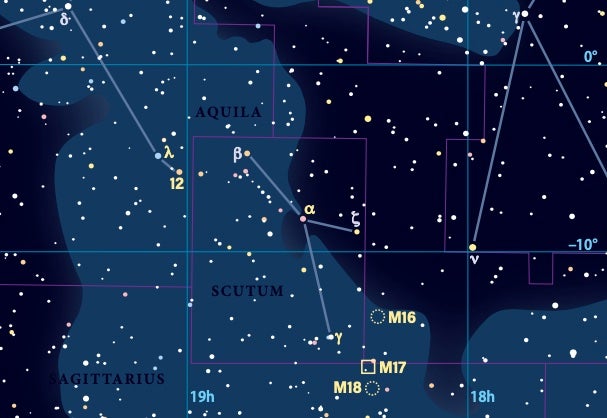
In his 1888 book Astronomy With an Opera-Glass, Garrett Serviss wrote: “The Milky Way, streaming down out of the northeast, pours, in a luminous flood, through Sagittarius, inundating that whole region of the heavens with seeming deeps and shallows, and finally bursting the barriers of the horizon.”
Hidden within the myriad stars in the summer Milky Way are many wonderful star clusters and nebulae to enjoy through binoculars. This month, let’s explore three that found their way into Charles Messier’s famous catalog. All are positioned within about 3° of each other, so once you find one, the others can’t be far away.
Start your quest at Aquila the Eagle. Zero in on its tail stars, Lambda (λ) and 12 Aquilae, with your binoculars. Continue the line connecting Lambda to 12 for 7°, or about a field of view, to 4th-magnitude Alpha (α) Scuti. From here, shift 6.5° south-southwest to 5th-magnitude Gamma (γ) Scuti. That’s where you’ll find our three featured objects, all set in a beautiful, star-filled field.
My favorite, M17, was discovered by Swiss astronomer Jean-Philippe Loys de Chéseaux in 1745 or 1746. M17 goes by several nicknames, among them the Swan Nebula, the Omega Nebula, and the Horseshoe Nebula. Charles Messier first saw it on June 3, 1764. He wrote that it looked like “a train of light without stars … in the shape of a spindle.” Most binoculars show only the brightest hook-shaped portion of this complex cloud, looking like a swan’s curved neck; it reminds others of the numeral 2 or even a checkmark.
M17 is a huge, glowing cloud of ionized hydrogen peppered with clouds of cosmic dust. Embedded within the nebula are the young, hot stars of open cluster NGC 6618. Their energy ionizes the hydrogen in the nebula, causing it to glow. The brightest cluster stars shine at 9th magnitude and may only be visible through larger binoculars on a steady mount.
From M17, scan 2½° north, crossing into Serpens Cauda for M16. Like M17, it was also discovered by de Chéseaux in either 1745 or 1746. When Messier spotted it, he described the sight as “a cluster of small stars, enmeshed in a faint glow … with an inferior telescope this cluster appears like a nebula.” So, while M16 is famously known as the Eagle Nebula, the entry in the Messier catalog actually refers to the associated open cluster. The Eagle Nebula is separately cataloged as IC 4703.
The Eagle Nebula was made famous by the Hubble Space Telescope in 1995 with the iconic “Pillars of Creation” image. It made the news again last year when the James Webb Space Telescope released an even more detailed image of the pillars in near-infrared light.
Don’t expect to see the nebula through your binoculars, however. Nebulae typically require larger apertures and narrowband nebula filters, as well as dark, clear skies. Binoculars will show about a dozen stars against the soft glow of unresolved cluster stars. But if you hold a pair of nebula filters between your binocular eyepieces and your eyes, a hint of the Eagle Nebula can be glimpsed around the outer edge of M16.
Finally, we have M18, lying just 1° south-southwest of M17. Messier discovered this open cluster on the same night he first viewed M16 and M17. Through our binoculars, M18 reveals a few dim stars set in a triangular pattern surrounded by fainter cluster stars melding into a dim haze. The cluster itself may be weakly structured, but its true beauty is in its surroundings. William Tyler Olcott noted in his 1909 book In Starland With a Three-Inch Telescope that “M18 is in a glorious field. ‘A region of surpassing splendor.’ ”
Olcott’s words come to life over a century later as you sit back and take in M16, M17, and M18 and their densely packed environs all in a single binocular field. The star-spangled scene is sure to become a favorite of yours, as it has mine.
Questions, comments, suggestions? Drop me a line via my website, philharrington.net. Until we meet again, remember that two eyes are better than one.









